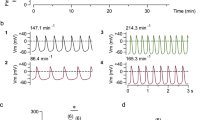Abstract
The role for fiber orientation as a determinant of conduction and block in the posterior (slow pathway, SP) and anterior (fast pathway, FP) AV nodal inputs was examined using multiple extracellular bipolar and intracellular microelectrode recordings in the superfused canine AV junction (N = 14).
Results: In both inputs, antegrade longitudinal conduction velocity decremented in association with decreased action potential amplitude and dV/dt max. A similar decrement was also present in the SP transverse to fiber orientation. SP conduction block occurred preferentially near its insertion into the compact AV node with very slow conduction (0.05 ± 0.01 M/sec) preceding conduction block. Distal antegrade FP conduction block occurred before conduction block occurred at more proximal FP sites. Conduction in the distal FP was maintained at a higher velocity (0.11 ± 0.01 M/sec, p < 0.05 vs. SP) before 2:1 conduction block was observed. Conduction velocity, action potential amplitude, and dV/dt max were not different at any SP or FP site for paired activation transverse and longitudinal to fiber orientation.
Conclusions: The data do not demonstrate a role for fiber orientation determining decremental conduction and block in transitional cell AV nodal inputs. Decremental conduction in both the SP and FP inputs is consistent with a proximal-to-distal gradient in resting membrane potential, action potential amplitude, dV/dt max, and intracellular excitability in transitional cells during antegrade activation.
Similar content being viewed by others
References
Paes de Carvalho A, de Almeida DF. Spread of activity through the atrioventricular node. Circ Res 1960;8:801–809.
Janse MJ. Influence of the direction of the atrial wavefront on A-V nodal transmission in isolated hearts of rabbits. Circ Res 1969; 25:439–449.
van Capelle FJL, Janse MJ, Varghese PJ, Freud GE, Mater C, Durrer D. Spread of excitation in the atrioventricular node of isolated rabbit hearts studied by multiple microelectrode recording. Circ Res 1972;31:602–616.
Spach MS, Lieberman M, Scott JG, Barr RC, Johnson EA, Kootsey JM. Excitation sequences of the atrial septum and the AV node in isolated hearts of the dog and rabbit. Circ Res 1971;29:156–172.
Anderson RH, Janse MJ, van Capelle FJL, Billette J, Becker AE, Durrer D. A combined morphological and electrophysiological study of the atrioventricular node of the rabbit. Circ Res 1974;45:909–922.
Mazgalev T, Dreifus LS, Iinuma H, Michelson EL. Effects of the site and timing of atrioventricular nodal input on atrioventricular conduction in the isolated perfused rabbit heart. Circulation 1984;70:748–759.
Racker DK. Atrioventricular node and input pathways: A correlated gross anatomical and histological study of the canine atrioventricular junctional region. Anat Rec 1989;224:336–354.
McGuire MA, de Bakker JMT, Vermeulen JT, Opthof T, Becker AE, Janse MJ. Origin and significance of double potentials near the atrioventricular node: Correlation of extracellular potentials, intracellular potentials, and histology. Circulation 1994;89:2351–2360.
McGuire MA, Robotin M, Yip ASB, Bourke JP, Johnson DC, Dewsnap BI, Grant P, Uther JB, Ross DL. Electrophysiologic and histologic effects of dissection of the connections between the atrium and posterior part of the AV node. J Am Coll Cardiol 1994;23:693–701.
Scherlag BJ, Patterson E, Nakagawa H, Hirao K, Jackman WM, Lazzara R. Changing concepts of A-V conduction: Basic and clinical correlates. Primary Cardiol 1995;21:13–24.
Billette J, Shrier A. Atrioventricular nodal activation and functional properties. In: Zipes DP and Jaliffe J, eds. Cardiac Electrophysiology: From Cell to Bedside. Philadelphia, PA: WB Saunders, 1995.
McGuire MA, Bourke JP, Robotin MC, Johnson DC, Meldrum-Hanna W, Nunn GR, Uther JB, Ross DL. High resolution mapping of Koch's triangle using sixty electrodes in humans with atrioventricular junctional (AV nodal) reentrant tachycardia. Circulation 1993;88:2315–2328.
Hirao K, Scherlag BJ, Poty H, Otomo K, Tondo C, Antz M, Patterson E, Jackman WM, Lazzara R. Electrophysiology of the atrio-nodal inputs and exits in the normal dog heart: Radiofrequency ablation using an epicardial approach. J Cardiovasc Electrophysiol 1997;8:904–905.
Antz M, Scherlag BJ, Patterson E, Otomo K, Tondo C, Pitha J, Jackman W, Lazzara R. Electrophysiology of the right anterior approach to theAVnode: Studies in vivo and in the isolated perfused dog heart. J Cardiovasc Electrophysiol 1997;8:47–61.
Tawara S. Das Reizleitungssytem des saugetier Herzens. Jena, Germany: Gustav Fischer, 1906.
Racker DK. Gross anatomical, histological, and electrophysiological definitions of AV nodal inputs in the canine heart. PhD Thesis, University of Health Sciences/The Chicago Medical School, Illinois.
Racker DK. The demonstration of intercellular coupling between cells of the canine distal AV bundle using lucifer yellow-CH and histologic sections. J Mol Cell Cardiol 1989;21:479–493.
Spach M, Josephson ME. Initiating reentry: The role of non-uniform anisotropy in small circuits. J Cardiovasc Electrophysiol 1994;5:182–209.
Hocini M, Loh P, Ho SY, Sanchez-Quintana D, Thibault B, de Bakker JMT, Janse MJ. Anisotropic conduction in the triangle of Koch of mammalian hearts: Electrophysiologic and anatomic correlations. J Am Coll Cardiol 1998;31:629–636.
McGuire MA, de Bakker JMT, Vermeulen JT, Moorman AFM, Loh R, Thibault B, Vermeulen JLM, Becker AE, Janse MJ. Atrioventricular junctional tissue: Discrepancy between histologic and electrophysiologic features. Circulation 1996;94:571–577.
Lewis T, Mater AM. Observations upon conduction in the mammalian heart. A-V conduction. Heart 1925;12:209–269. 148 Patterson and Scherlag
Mendez C, Moe GK. Demonstration of a dual A-V nodal conduction system in the isolated rabbit heart. Circ Res 1966;19:378–393
Choi B-R, Salama G. Optical mapping of atrioventricular node reveals a conduction barrier between atrial and nodal cells. Am J Physiol 1998;274:H829–H845.
Patterson E, Scherlag BJ. Longitudinal dissociation within the posterior AV nodal input of the rabbit: A substrate for AV nodal reentry. Circulation 1999;99:143–155.
Patterson E, Scherlag BJ. Slow:fast and slow:slow AV nodal reentry in the rabbit resulting from longitudinal dissociation within the posterior AV nodal input. J Intervent Cardiac Electrophysiol (in review).
Author information
Authors and Affiliations
Rights and permissions
About this article
Cite this article
Patterson, E., Scherlag, B.J. Decremental Conduction in the Posterior and Anterior AV Nodal Inputs. J Interv Card Electrophysiol 7, 137–148 (2002). https://doi.org/10.1023/A:1020833604423
Issue Date:
DOI: https://doi.org/10.1023/A:1020833604423




